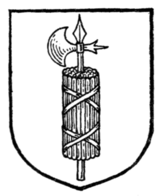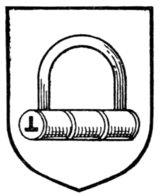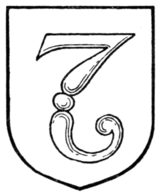ancient warfare shields were sometimes strengthened by being bound with iron bands radiating from the centre, and these bands, from the shape they assumed, became in course of time a charge in themselves under the term escarbuncle.
The crest of the Fanmakers' Company is: "A hand couped proper holding a fan displayed," while the chief charge in the arms is "... a fan displayed ... the sticks gules." This, however, is the only case I can cite of this object.
The Fasces (Fig. 533), emblematic of the Roman magisterial office, is very frequently introduced in grants of arms to Mayors and Lord Mayors, which no doubt accounts for its appearance in the arms of Durning-Lawrence, Knill, Evans, and Spokes.
 Fig. 533.—Fasces. |
 Fig. 534.—Fetterlock. |
 Fig. 535.—Fleam. |
An instance of Fetterlocks (Fig. 534) occurs in the arms of Kirkwood, and also in the coat of Lockhart and the crest of Wyndham. A chain is often substituted for the bow of the lock. The modern padlock has been introduced into the grant of arms to the town of Wolverhampton.
Keys, the emblem of St. Peter, and, as such, part of the insignia of His Holiness the Pope, occur in many ecclesiastical coats, the arms of the Fishmongers' Livery Company, and many families.
Flames of Fire are not frequently met with, but they are to be found in the arms of Baikie, and as crests they figure in the achievements of Graham-Wigan, and also in conjunction with keys in that of Flavel. In connection with certain other objects flames are common enough. The phœnix always issues from flames, and a salamander is always in the midst of flames (Fig. 437). The flaming sword, a device, by the way, included in the recent grant to Sir George Lewis, Bart., has been already alluded to, as has also the flaming brand. A notable example of the torch occurs in the crest of Sir William Gull, Bart., no doubt an allusion (as is his augmentation) to the skill by which he kept the torch of life burning in the then Prince of Wales during his serious illness in 1871. A flaming mountain occurs as the crest of several families of the name of Grant.
